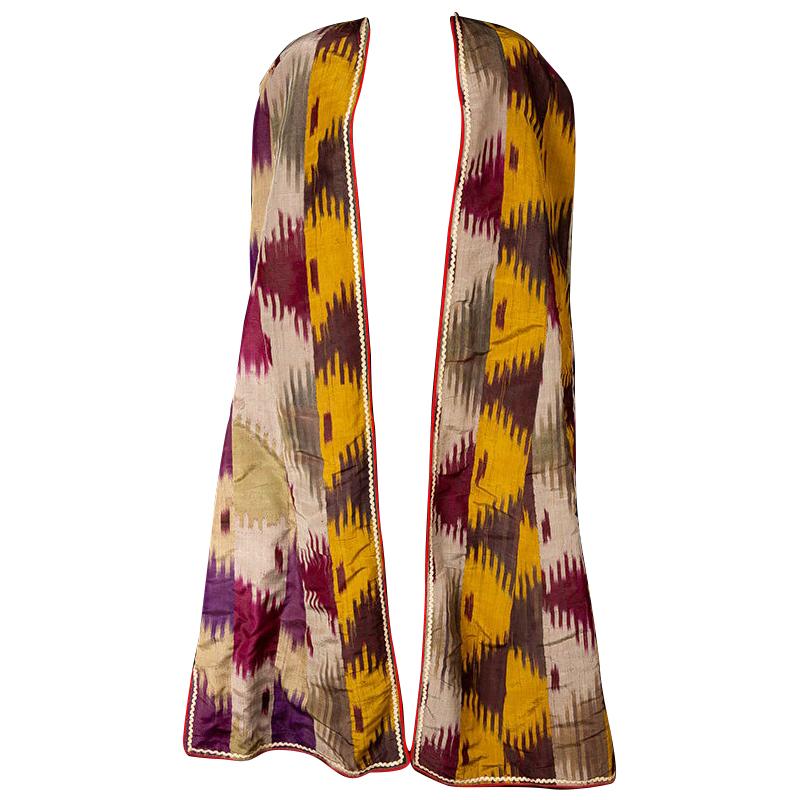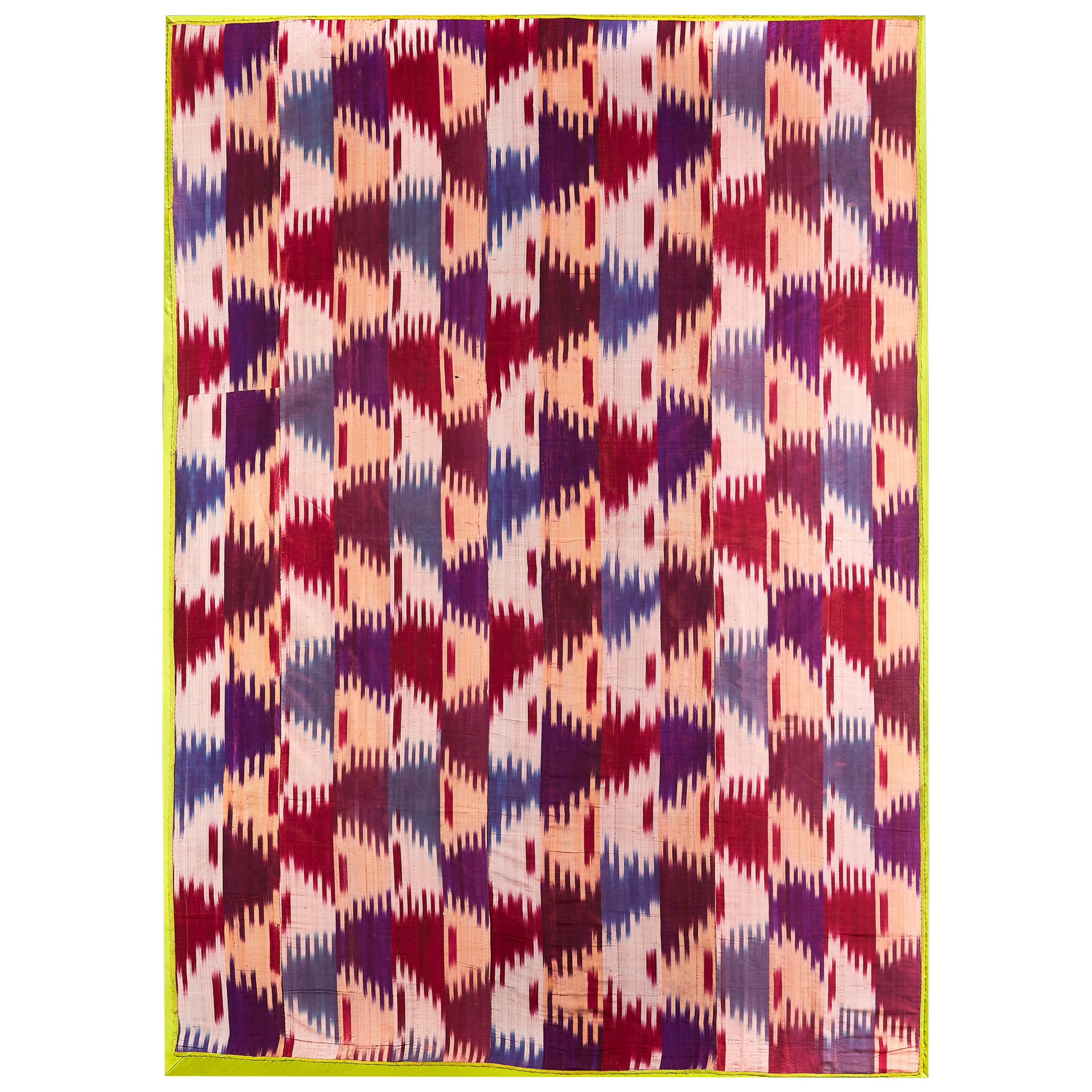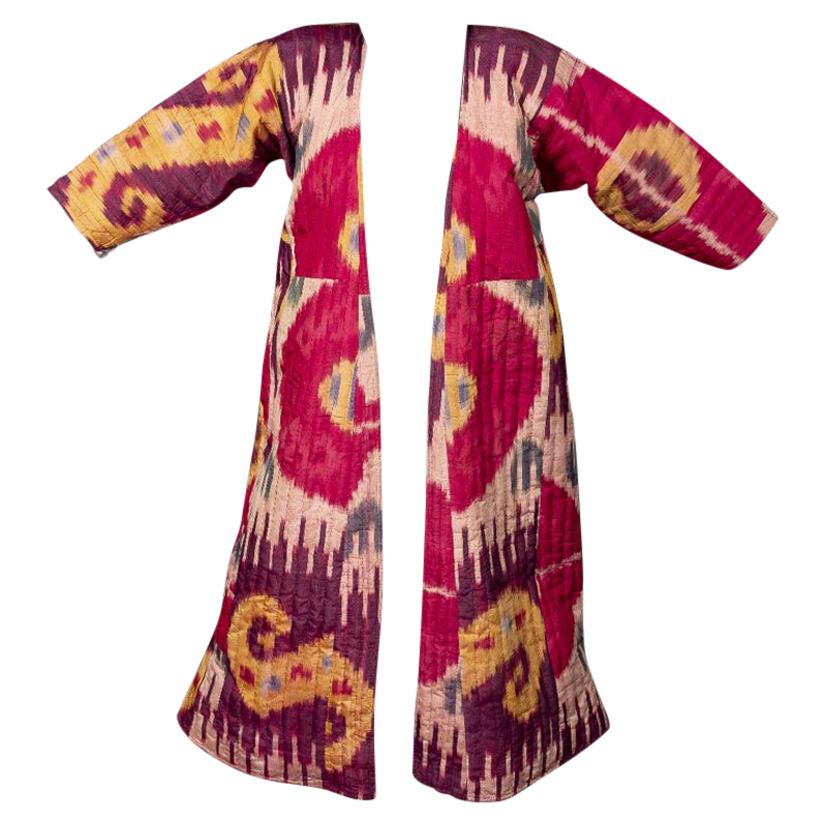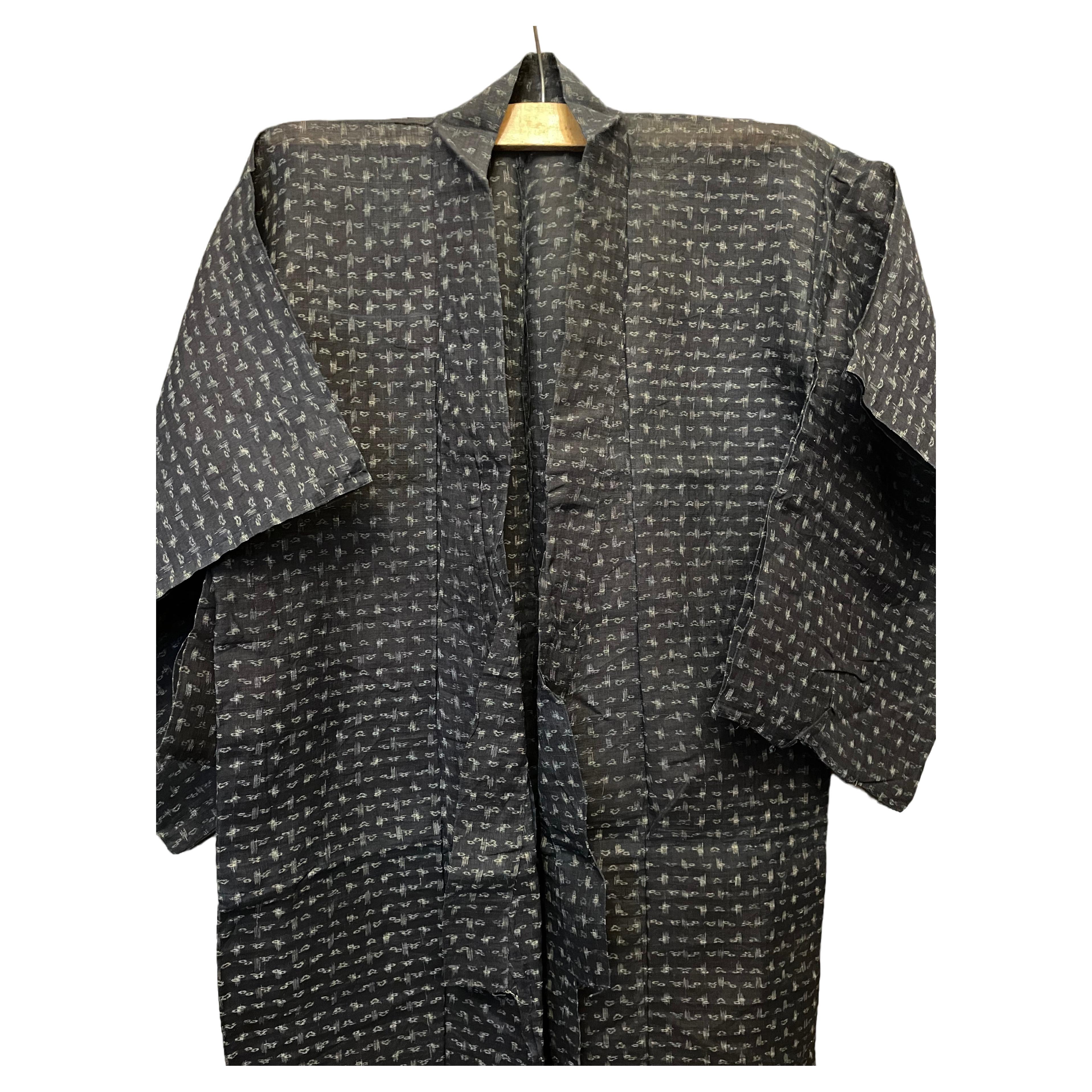Want more images or videos?
Request additional images or videos from the seller
1 of 9
Ikat Chyrpy, Central Asia
About the Item
Striking hand-woven chyrpy with a checkered triangle pattern in vibrant colours. Women in Uzbekistan and Northern Afghanistan wore this outdoor veiling garment (paranja/chrypy) in traditional colours of dark blues, green and grey – colours considered appropriately modest by local tradition. The beautiful rich colours are all natural and applied into the design with a master’s touch. They are worn over the tunic in cloak-fashion, covering the head and shoulders, with the long vestigial sleeves hanging down the back and joined by an embroidered band. It is in excellent condition. a masterpiece.
By the end of the 19th century, wealthy women began wearing silk ikat and striped fabrics (prior to this, only members of the court were allowed), and coats were produced in bright colours – yellow, light blue and even pink.
Ikat weaving has emerged from different parts of the world independently, however it is ikat from Uzbekistan, defined as abrabandi, meaning “bound cloud” which is the most captivating. The word ‘ikat’ comes from the Malaysian word ‘mengikat’ or ‘to tie’, because the loose threads are tied into bundles using grasses or wax-treated cotton to specify where the dye is able to sink in and color the thread. The threads are dyed before they are woven into the textiles.
A characteristic of ikat textiles is an apparent “blurriness” to the design. The blurriness is a result of the extreme difficulty the weaver has lining up the dyed yarns so that the pattern comes out perfectly in the finished cloth. The blurriness can be reduced by using finer yarns or by the skill of the craftsperson. Ikats with little blurriness, multiple colours and complicated patterns are more difficult to create and therefore often more expensive. However, the blurriness that is so characteristic of ikat is often prized by textile collectors.
The Silk Road was a network rather than a single highway, at the heart of which sat what we know today as Uzbekistan, where mountain and steppe meet desert. A succession of empires lost and won by nomadic invaders have left behind a unique melting pot of cultures. Merchants, pilgrims, and envoys were attracted here, not only by trade but also by exchanges in religion, technology and the arts. Where these people met, so too did their ideas and their creativity, one of the most original and visually dramatic examples of Central Asian silk. The clarity, saturation and depth of colour in classical ikats are their greatest artistic strengths. The eye is teased, tickled by the sophistication of the composition and the elegance of the forms.
Measurements: 146 cm H.
- Dimensions:Height: 57.48 in (146 cm)Width: 78 in (198.12 cm)Depth: 1 in (2.54 cm)
- Materials and Techniques:
- Place of Origin:
- Period:
- Date of Manufacture:19th Century
- Condition:
- Seller Location:San Pedro Garza Garcia, MX
- Reference Number:
About the Seller
3.7
Vetted Seller
These experienced sellers undergo a comprehensive evaluation by our team of in-house experts.
1stDibs seller since 2017
22 sales on 1stDibs
Typical response time: 18 hours
- ShippingRetrieving quote...Ships From: San Pedro Garza Garcia, Mexico
- Return PolicyA return for this item may be initiated within 3 days of delivery.
More From This SellerView All
- Ikat Chyrpy, Central AsiaLocated in San Pedro Garza Garcia, Nuevo LeonSpectacular hand-loomed Chyrpy with a checkered pattern, finished with a remarkable white wavy cotton edging. Women in Uzbekistan and Northern Afghanistan wore this outdoor veiling g...Category
Antique 15th Century and Earlier Asian Antiquities
MaterialsCotton
- Beautiful Ikat Munisak, Uzbekistan, 19th CenturyLocated in San Pedro Garza Garcia, Nuevo LeonA beautiful Ikat Munisak – a woman’s uzbek robe – in traditional pomegranate design symbolizing fertility. It has a square patch in Magenta with a flower mo...Category
Antique 15th Century and Earlier Asian Antiquities
MaterialsCotton
- Chimera (Pixiu) Terracotta Mythological Being - Tang Dynasty, China '618-907 AD'Located in San Pedro Garza Garcia, Nuevo LeonMagnificent Mythological Being "Chimera" with Human Face and Flaming Rays Halo. Orange Terracotta with Traces of Stucco and Painting. This creature is commonly known as Pixiu. Fierc...Category
Antique 15th Century and Earlier Chinese Tang Antiquities
MaterialsTerracotta
- Eastern Han Dynasty Terracotta Model of a Paper Mill , China '206BC - 220AD'Located in San Pedro Garza Garcia, Nuevo LeonSlab pottery constructed Model of a Paper Mill, in Green and Cream Color Glazed Terracotta having a peaked roof – open walled form with a mechanical pounder and a large round storage container. Light blue-green mottled glazed surface with some iridescence patina to the glaze. The Iridescence is a refraction of the layers on the glass that produces multicolor hues & metallic luster, and only develops after one thousand years of being buried in the ground. An unquestionable mark of antiquity, impossible to falsify. Han Dynasty, dated 206 B.C-220 A.D. Condition: Excellent, wear commensurate with age, an unusual example. This fantastic piece is accompanied by a Certificate of Authenticity. Sculptural effigies of domesticated animals were often interred in the tombs of nobility and elite members of the social hierarchy. Models like this one were made to represent everything from simple goat or pig pens to the most elaborate towers and palaces. Because very few ancient Chinese buildings have survived intact, these models, along with descriptions from ancient texts, give a good representation of what the buildings might have looked like. Burial figurines of graceful dancers, mystical beasts, and everyday objects reveal both how people in early China approached death and how they lived. Since people viewed the afterlife as an extension of worldly life, these figurines, called mingqi, sometimes referred as “spirit utensils” or “vessels of ghosts” disclose details of routine existence and provide insights into belief systems over a thousand-year period. For the first time in Chinese history, we have images of rural and daily life during the Han in the form of contemporary records...Category
Antique 15th Century and Earlier Chinese Han Antiquities
MaterialsTerracotta
- Monumental Han Dynasty Terracotta Horse - TL Tested - China, '206 BC–220 AD'Located in San Pedro Garza Garcia, Nuevo LeonA massive pottery horse with separately made head and tail, standing on all fours and striding with its right hoof forward. Extended snout ends in parted lips showing teeth beneath i...Category
Antique 15th Century and Earlier Chinese Han Antiquities
MaterialsTerracotta
- Ming Dynasty Chinese Countryside Villa - TL TestedLocated in San Pedro Garza Garcia, Nuevo LeonExtremely rare Chinese model of a countryside villa for the royal courtiers and ministries of the Ming Dynasty -1368-1644 AD- showing three guest houses and one main entry. The villa is surrounded by a cuadrangular wall painted with bucolic scenes of garden, mountains, and bamboo forests. The roof tiles are glazed in green enamel with yellow finials – as the ones in the forbidden city – typical from the Ming epoch. Truly a museum piece. The doors swivel and are painted in ochre. State of preservation: impeccable mint condition with original paintings, all of the original parts are complete, except for one house which is missing part of the plinth (broken during transport). Each part has been tested for authenticity, consisting of eight separate TL tests...Category
Antique 15th Century and Earlier Chinese Ming Antiquities
MaterialsTerracotta
You May Also Like
- Early 20th Century Central Asian IkatLocated in London, GBA large panel of Central Asian Ikat, decorated with diffuse colours in red, aubergine, and pale cream, in a continuous abstract pattern, bordered with lime green silk, stretched and ...Category
20th Century Uzbek Textiles
MaterialsSilk
- Antique Ikat Dyed Uzbek Silk RobeLocated in Delray Beach, FLBeautiful bright and colorful Antique Ikat silk Dyed Uzbek Robe. Has minor wear and tear shown in photos. Colors: Fuchsia, light pink, purple, yellow and bl...Category
Vintage 1920s Uzbek Textiles
MaterialsSilk, Cotton
- Vintage Woven Ikat Chapan Robe Central Asia UzbekistanLocated in Atlanta, GAChapan is the iconic fornt-open flowing robe traditionally worn by the nomadic people in Central Asia. In countries like Uzbekistan, it was almost the old national costume. This Uzbe...Category
Mid-20th Century Uzbek Tribal Textiles
MaterialsCotton
- Japanese Cotton Kimono IKAT Kasuri 1970s ShowaLocated in Paris, FRThis is a kimono made in Japan called kasuri. This kasuri kimono was made around 1970s. It was used to wear by some peasants to work. This is made with cotton Ikat. Dimensions: Heig...Category
Vintage 1970s Japanese Showa Antiquities
MaterialsCotton
- Carved Asian amber snuffbottleLocated in Hamburg, DEntroducing our exquisite Asian Snuff Bottle, a true masterpiece crafted from the finest amber. This captivating piece boasts intricate relief carvings on its surface, showcasing the skilled craftsmanship of our artisans. The amber body of the bottle exudes a warm and inviting aura, making it a unique and elegant addition to any collection. The horn spoon and lid add a touch of authenticity, highlighting the attention to detail in its design. This snuff bottle is not just a collectible; it’s a work of art that reflects the rich cultural heritage of Asia. Elevate your appreciation for traditional craftsmanship with this extraordinary amber snuff bottle...Category
Antique Late 19th Century Qing Antiquities
MaterialsResin
- Asian Rosewood dry barLocated in Waxahachie, TXAsian Rosewood dry bar cabinet flip top. Multiple doors on all sides. Corner opens up 5 shelves. The sides open to hold 4 larger shelves. The open top shows Ancient style carved artw...Category
Antique Late 17th Century Asian Chinoiserie Antiquities
MaterialsWood
Recently Viewed
View AllMore Ways To Browse
Furniture Asian
Century Furniture Asian
Asian Used Furniture
Asian Furniture Used
Antique Asian
Asian Antique
Asia Antique
Antique Furniture Asian Antiques
Antique Asian Furniture
Antique Asian Furniture Furniture
Asian Antique Furniture
With Asian Design
Antique Asian Art
Central Asia
Traditional Asian Furniture
Blue Asian
Asian Cans
Asian Fine Art





